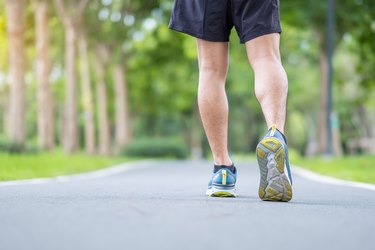

The calves have a reputation for being the hardest muscles to grow. But dedicated training can help you build strong, powerful calf muscles.
- What Are Seated Calf Raises? They're heel-lift exercises where you sit down and raise a weight using your calves.
- Calf Raise Muscles Worked: Your calves contain two separate muscles: the soleus and gastrocnemius ("gastroc" for short). Though it's hard to see, the soleus runs the entire length of the lower leg, helping your lower body move. The gastroc is at the top of the calves, connecting to the knee. Sitting raises mainly target the soleus. (FYI, standing calf raises focus on the gastroc.)
- Who Can Do This Exercise? Anyone that's free of lower-body injury can do this exercise.
- Can You Do This Move at Home? Absolutely! You can do this exercise right at home without a machine, using a dumbbell, barbell or any weighted object.
Video of the Day
Ready to give your calves the attention they deserve? Here's everything you need to know about this exercise.
How to Do a Seated Calf Raise
Want to learn how to do sitting calf raises in the most effective way possible? Follow these step-by-step instructions from New York-based certified personal trainer Carolina Araujo, CPT.
Seated Calf Raise
- Begin seated with a flat back and a moderate or heavy dumbbell resting across your thighs, just above your knees.
- Remaining seated, press through the balls of your feet to raise your heels and the dumbbell as high as possible.
- Pause here for a moment then slowly lower your heels back to the floor.
Tip
To get even more from your calf raises, use a full range of motion, Araujo says. Follow the above step with the balls of your feet on top of a weight plate or thick book. Start and end each rep with your heels on the floor.
How Many Sitting Calf Raises Should You Do?
"If you're a beginner, you can start by doing this exercise with a low weight for 3 sets of 10 to 12 reps," Araujo says. If you're not sure of which dumbbell weight to use, start low — 15 to 20 pounds should do the trick. Calves can easily get delayed muscle soreness, so get a feel for how your body responds before using a heavier weight.
As you get stronger, you can increase your reps and use heavier dumbbells or even weight plates, depending on what you have available. 3 to 4 sets of 12 to 15 reps is an excellent goal for growing your calf muscles, she says.
Calf Raise Exercise Benefits
Some of the obvious benefits of sitting calf raises include increased calf muscle strength and size. And while that obviously changes how your legs look, it also changes how they perform, Araujo says.
With stronger calves, your whole legs work better. You boost your running and jumping performance. Even day-to-day tasks such as walking and climbing stairs become easier, she says.
Since your soleus hooks into your ankle, doing this exercise can also help lower your risk of ankle injury. It can also reduce your risk of shin and knee injuries.
Calf Raise Variations
Calf Raise Machine
Your gym may have a seated calf raise machine available, which is a great option, too.
You can use this by placing your feet on the base of the machine and adding plates onto the front or sides. Release the lever that keeps the weight stationary. Then raise and lower the weight as usual. Make sure to lower your heels as far as comfortable with each rep.
Barbell Calf Raise
A dumbbell isn't the only free weight you can use at home to do seated calf raises without a machine. Try doing the lower-leg exercise with a short or long barbell across the tops of your thighs.
Exercise Progressions
To make this move more difficult, try these progressions. They all work with both free-weights and machines.
Increase Weight
Adding more resistance is a surefire way to see more strength gain from your calf raises, Araujo says.
Doing seated calf raises with a barbell (always secure plates with safety clips), is a great way to comfortably increase weights. Place a foam pad or towel under the barbell for extra cushion.
Pause at the Top
Performing stationary (isometric) holds can promote growth by keeping the muscle working (aka: under tension) longer, according to the American Council on Exercise (ACE).
So, at the top of the motion, hold the raise for three to four seconds before lowering your heels back to the floor.
Lower the Weight Slowly
Slowing down the lowering (eccentric) part of the exercise is another way to gain muscle, per the ACE.
When you lower your heels to the floor at the end of each rep, slow down the motion to last three to four seconds.
Make Them Unilateral
One-sided or unilateral exercises address muscle imbalances and help strengthen each side of your body more equally, according to the ACE.
Try performing all of your reps on one leg, followed by the other, to see which of your calf muscles is stronger.
Related Reading
Was this article helpful?
150 Characters Max
0/150
Thank you for sharing!
Thank you for your feedback!